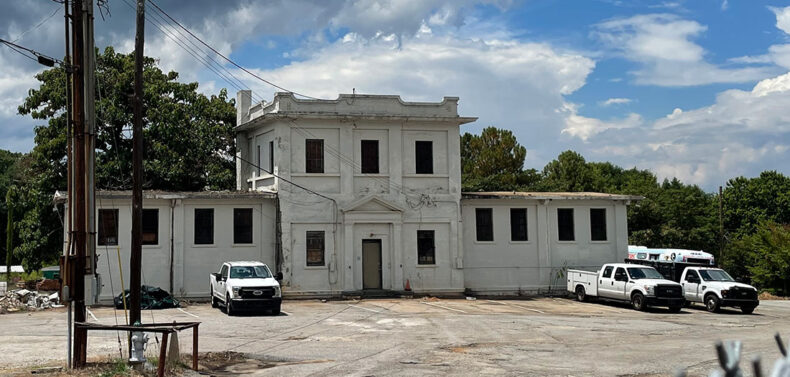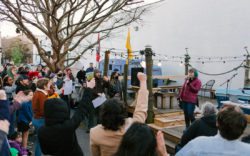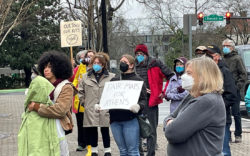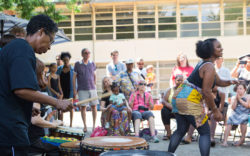Athens’ old City Stockade, perhaps fittingly, finds itself trapped. In limbo, in obscurity, the building is now, in a way, subject to the confinement it was meant to impose.
Sequestered away in the farthest back corner of Normaltown in a no-man’s land squeezed against the Loop, the stockade and its story have been largely locked away. Unlike so many of the notable Athens buildings that seem to insist they have a story to tell, the old stockade appears stolid and mute. But the stockade tells us a story of Athens—a story of the city’s growth and modernization, a story of bitter oppression and the struggle for freedom.
For the better part of the 20th century, the stockade was a jail. Thus, it is a building whose story consists of the lives it held only briefly. For that reason, its story is difficult to tell.
Nor does the building’s appearance help its case. Looking like something of an accident or afterthought at Boulevard’s terminus, the all-white structure can strike one as almost sickly or lost, reminiscent of a beached whale left to fester, skirted in recent years by a scrum of buses in its service as depot for the county fleet. In a city full of compelling buildings, structures, landmarks and monuments, the old stockade is strikingly featureless and drab. “City Stockade, Built Entirely of Concrete,” boasted an ad from contractor H.L. Stewart in the Athens Daily Herald in 1914 under a photo of the austere structure. “Everything Concreted, Both Interior and Exterior, Excepting the Doors.” It’s never going to win a beauty contest.
The Birth of Prisons
Clarke County’s stockades allow us a prism through which to view Athens during a period of enormous change and growth at the dawn of the 20th century. It would be a period in which Southern whites sought a return to brutal racial power through the system of laws and imprisonment. “By 1900, the South’s judicial system had been wholly reconfigured to make one of its primary purposes the coercion of African Americans to comply with the social customs and labor demands of whites,” explains legal scholar Michelle Alexander. The century’s opening saw the relatively amorphous state of post-emancipation race relations harden into the legal apparatus of an apartheid state, euphemistically called “Jim Crow.” A series of developments culminating in the Plessy v. Ferguson ruling in 1896 set the stage for the 20th century to be a dark one.
So, as the 20th century opened, law enforcement in the South was largely intended to do two things: maintain a system of white control and extract free labor from Black detainees. Rarely does history offer clean, sharp delineations, but it was on Jan. 1, 1900 that Clarke County opened its first stockade, a less ambitious facility to precede the eventual city stockade. The stockade would be the site to enforce Alexander’s social and labor control.
The central distinction between a stockade and a jail (Athens would have both) is that convicts in stockades were made to work. The 13th Amendment had not abolished slavery entirely: “Neither slavery nor involuntary servitude… shall exist within the United States,” reads the amendment, “except as a punishment for crime.” As Douglas Blackmon has detailed in his Pulitzer Prize-winning Slavery by Another Name, Southern whites found this loophole large enough to return hundreds of thousands of Black Southerners to a form of slavery virtually indistinguishable from the brutal forced labor the white South had been briefly denied after their Civil War defeat by the North and the United States military.
Countless Black Southerners would be pulled back into a system of slavery often more brutal than its earlier form. And here in the midst of the Second Industrial Revolution, this new slavery of the 1900s would be of a more modern character. Athens was leaving the quiet agrarian age of the 19th century and rocketing toward modernity. The first automobile appeared in Athens in 1899. The Wright Brothers’ first flight in 1903 was followed closely by Athens’ Ben Epps, who pioneered flight in Georgia just a few years later. The Murmur trestle, completed in 1883, at long last properly connected downtown Athens to the modernizing global economy, and Athens was, in 1900, becoming something almost unrecognizable from its sleepier self of the 19th century. This new Athens, and its new wealth, is what its Black inhabitants would be made to build and yet excluded from sharing in.
The acceleration underway in 1900 was unique in the city’s history, before or since. “The building boom of the 1880s and 1890s continued unabated into the early twentieth century, as much of downtown assumed a character and appearance little changed today,” writes Frances Thomas in A Portrait of Historic Athens and Clarke County. Much of the Athens skyline we’re familiar with was built during that first decade of the century. The city organized the Chamber of Commerce in 1903 to guide the unprecedented expansion, and by the end of the decade the Athens Banner would proclaim Athens “one of the largest cotton markets in the world.”
New advances in agricultural methods had made the surrounding area rich in cotton, and Athens was the place where those regional profits were realized, the entry point of the global supply chain. Athens soon had 12 cotton manufacturing plants, a cotton oil refinery, two oil mills and three fertilizer plants. Athens was, by 1910, “handling more wagonloads of cotton than any other town in Georgia,” according to the Banner. Money poured in. The population was quickly on its way to doubling. New banks opened to handle the new wealth, new stores and merchants multiplied, and modern electric lights soon illuminated the downtown of this pulsing hub of commerce.
Roads to Serfdom
What Clarke County did not have were efficient, passable roads to fully integrate into the modernizing supply chain on which Athens’ growing wealth was dependent. This was a dirt-road county, and this modern economy didn’t run on dirt roads. County leaders saw the economic imperative in laying all-weather, hard-surface roads to move all of these new goods. But the going way of paving roads was endlessly arduous, with few modern machines available to crush quarried stone into gravel or to physically grade the land of the roadways. Then you had to lug the tons of crushed stone over scores of miles of road and commence this whole new process of macadamized roads, or layering different grades of crushed stone to form a durable hard surface.
If railroads were the arteries for this new economy, roads “might be considered as the capillaries or feeders” to engage with the beating heart of capitalism and “just as vital to the satisfactory working of the system,” explained Scientific American in 1908. But while the existing dirt roads of Clarke County required only “moderate annual expenditures,” the magazine reported, these new macadamized roads demanded far larger outlays. “The increased expenditure has been so great as to justly alarm the authorities throughout the country responsible for the use of the roads.” The era’s labor victories made waged work of this sort prohibitively expensive. “In these days of high-paid labor and short working hours one rarely hears in this country of macadam stone being broken by hand,” reported Scientific American. However, “it is true that in some of the states prison labor may be used for this purpose.”

The South had, by now, effectively reinvented slavery, and Athens’ white leaders quickly sought ways to tap back into forced labor for this hardest work. “The working of convicts on the public roads is a new scheme in Clarke county, but it is believed it will succeed,” read a local paper on the eve of the stockade’s opening. It was made clear that the stockade had one primary purpose: to house forced laborers, as many as could be gotten. “It is not profitable to work less than twenty convicts at a time,” worried the Banner. It was not crime that inspired this expansion of the local carceral system, but the work that could be gotten from chained men. Just as with slavery, this meant buying men to drive. Simply building the stockade was an immediate boon, as it meant 53 men at a forced labor camp in Elbert County would be imported to Clarke to build roads.
Athens was not alone in this rediscovery of slave labor. More and more Black men across Georgia would be swept up into the dark system on the flimsiest of charges, when there were identifiable charges at all. One might be abducted into this system for simply “leaving the farm of an employer without permission,” explains Blackmon. “Vagrancy” became a catch-all charge to bring more and more men into this carceral slavery. Just the suspicion of a Black man being involved with a white woman was enough to land him in a forced labor camp.
From Bad to Worse
The conditions for these newly enslaved workers were brutal and only seemed to get worse. Multiple escape attempts from Clarke County’s first stockade were made in just the first few days, and within the first month the county brought in five hounds to track the multiplying escapees. But despite the unconscionable brutality, plans began for a new in-town stockade to be built within the decade, opening in 1912. This new city stockade’s conditions we have a little more access to. A white detainee in the city stockade, Frank Saye, filed charges against the city for being “whipped unmercifully” in 1916, and press coverage of this white man being mistreated gives us a glimpse into how conditions were that much worse for the Black convicts. Saye, suffering from some manner of chronic illness, asked for a doctor when he was made to go out and work. The warden called for the “whipping boss” to break Saye, who was severely whipped while being held down.
Saye told investigators that, in just his short time in the stockade, he’d seen the warden “make two negro women fight until they had completely torn each others clothes off and until they were unable to stand.” He said he saw meat filled with vermin and men routinely whipped. The men worked under the threat of being beaten, which might explain a Black convict dropping dead while being worked around the same time.
Later, Northern journalist John Spivak would travel to Athens in 1931 and find documentation of the brutality in Athens’ convict labor system. In just his brief time here, Spivak discovered documentation of two deaths of Black men—one from “apoplexy,” or sudden death, and another gravely ill man apparently worked to death. Spivak also absconded with a “whipping report” from just one month in Athens, which found 50 savage beatings handed out in a single month, the majority being for “not working.” Another seven whippings were delivered for matters as trivial as “fussing” and “cursing.”

Despite the horrors of this new slavery, the hunger for labor and the need for racial control kept the system expanding. A statewide uproar in 1908 forced reforms in the state legislature of what the Atlanta Georgian called the “unspeakable cruelties” of carceral slavery in the state. The investigatory committee formed in the legislature was told of “convicts beaten to death, starved, overworked and sold like mules.” Daily reports of “indescribable filth, wretched food, inhuman driving and utter neglect” shocked readers, and the system of leasing state convicts to counties and private enterprises was eventually ended. So, while Clarke County saw its avid participation in this purchase of men on a statewide auction block come to an end, this may have only increased the need to violently conscript local men into forced labor.
A 1921 headline in the Athens Banner read, “Police Declare War on Vagrancy, Stockade Full.” This echoes the reporting from Blackmon on the use of “vagrancy” charges to acquire forced laborers for either city use or sale to businesses. Blackmon describes, for instance, how “after a plea for more cotton pickers in August 1932, police in Macon scoured the town’s streets, arresting sixty black men on ‘vagrancy’ charges and immediately turning them over to a plantation owner J.H. Stroud.”
The South’s brazen experiment in re-enslavement would end across the region by 1945, but the conditions in the city stockade in Athens continued to deteriorate. Through midcentury the conditions had degraded so much in Clarke County’s jails that a federal lawsuit was eventually brought in early 1970s. A federal judge would tour the county jail and deem the conditions “awful,” but while the “awful” county jail merely failed an inspection, the city stockade was deemed “unfit for occupation” by the same inspectors. A local reporter would remark that as bad as the county jail was, it “is a virtual paradise compared to the city’s stockade.” Only 4% of jails across the state received as abysmal a grade as the stockade.
Incarcerated Children
Despite its hellish conditions, the City Stockade would be where white Athens’ leaders chose to send protesters against segregation, many of them children, in the early 1960s. Once again, the stockade would serve as a site of overt racial control. Dozens of Athens children and a number of older protesters would be dragged by white police to be detained at the stockade for the crime of asking to be treated as a human and a citizen.
There was a vibrant and inspired civil rights movement in Athens at the time. The movement that had emerged in places like Birmingham, AL; Atlanta; Little Rock, AR and Greensboro, NC sparked the same passionate push for equality in Athens. The racist system constructed in Athens had cemented into a deeply unequal apartheid state. Black Athenians were excluded from political, economic and social power; Black children were barred from the better-funded white schools; Black adults and children alike were refused service at lunch counters and other white businesses; and white abuses, big and small, were permitted as though sanctioned by God. In the minds of many whites, they were.
Thus, when young Black Athenians began challenging the system, white Athens responded the way it always had: violence, both legal and extralegal. While it’s perhaps easier to recognize the extralegal violence of groups like the Ku Klux Klan as such, the latent and active violence of state power was far more pervasive and effective in maintaining the white supremacist order. While the Klan boasted a dues-paying membership of almost 400 around mid-century, complete with a headquarters above the former location of the Grit on Prince Avenue, it was the “legitimate” power of the police and imprisonment that most sustained the apartheid arrangement.
Hattie Thomas Whitehead recalls herself and the Athens children protesting segregation harshly rounded up by the busload by white police and deposited at the stockade. She and other children—Whitehead was 14 at the time—would gather at Ebenezer Baptist Church West to train with faith leaders in nonviolent tactics, then march to segregated establishments for the protest actions. Without fail, armed white police would deploy against the peaceful children.
The children, as well as their adult comrades, understood that police deployment meant that violence was in play. The white power structure maintained a monopoly on “legitimate” violence, and the police were the tip of that spear. Homer Wilson and his family understood that threat well enough, and Wilson, given to a young man’s quick temper, was kept from the front lines due to the police violence that could result from a lapse in strict nonviolent strategy.
In her book Voices of Linnentown, Whitehead describes the vile gauntlet white Athens designed for her and the other children asking for basic fairness. Arriving downtown to a segregated establishment, the children would find that “both edges of the sidewalk would be lined with white men and women shouting the N-word mixed with profanity, and women used their purses as weapons, hitting us as we walked by.” At times, the Klan itself would arrive and cast a deeper danger over the scene. And always waiting for the children was the ultimate threat possessed by the white power structure, the violence represented by the police. Once white Athens deployed their police, the dehumanization was complete, the protesters reduced to mere “disobedient” bodies under the control of white men with guns.
Whitehead and her comrades’ determination stood defiant in the face of white police power. “If we got locked up that night, we went back the next day. And the next day. And the next day,” she says. “You went back.” Indeed, they would continue to fight, and Whitehead and the other protesters helped bring the dawn. Throughout the 1960s, incremental civil rights victories would dismantle much of the overt apartheid that barred Black Athenians from opportunities in education, transportation, commerce and politics.
The stockade had perhaps finally lost its power as the oppressors’ tool. It had been allowed to fall into a ramshackle state, infested and grimy and, by all accounts, nightmarish inside. But the deeper stain was from its use. More macabre than its physical state was its history. Whatever new paint may lie in store for the building, only a redemptive use would wipe clean this taint.
The Prison-Industrial Complex
The derelict stockade would finally be decommissioned in 1978 in anticipation of a new, much larger jail. If the stockade opened at the dawn of the 20th century to commence a new system of white oppression in the South, its closure, too, signaled a new beginning in the carceral control of Black Americans. Both the stockade and its successor jail opened almost precisely at the moment of their need to the powers that be. This new jail would open just weeks after President Ronald Reagan’s election in 1980.
Reagan would inaugurate a turn toward mass incarceration and the intensification of policing. Reagan and his conservative, increasingly Southern coalition would code criminality in terms of race. The Southern scheme of incarceration as a mode of social control would infuse the national political posture under Reagan, and the country’s prison population would almost double during his eight years, with Black Americans disproportionately locked up and targeted by police. The course steered by Reagan would eventually give the country the ignominious distinction of having more of its citizens locked up than any country on Earth.
For the better part of a century, the stockade had served its purpose as a tool of social and racial control. But America’s insatiable thirst for caging its citizens, especially Black Americans, finally rendered the facility inadequate to the new scale of incarceration. Decades of inhumane conditions between its walls had not shuttered the stockade; the barbaric treatment of its inmates had not caused its closure; the vermin and pestilential rot inside had not put an end to the whites’ dungeon. No, it was finally closed because it was no longer big enough to be of assistance in the new world of mass incarceration that was fast approaching.
Like what you just read? Support Flagpole by making a donation today. Every dollar you give helps fund our ongoing mission to provide Athens with quality, independent journalism.









